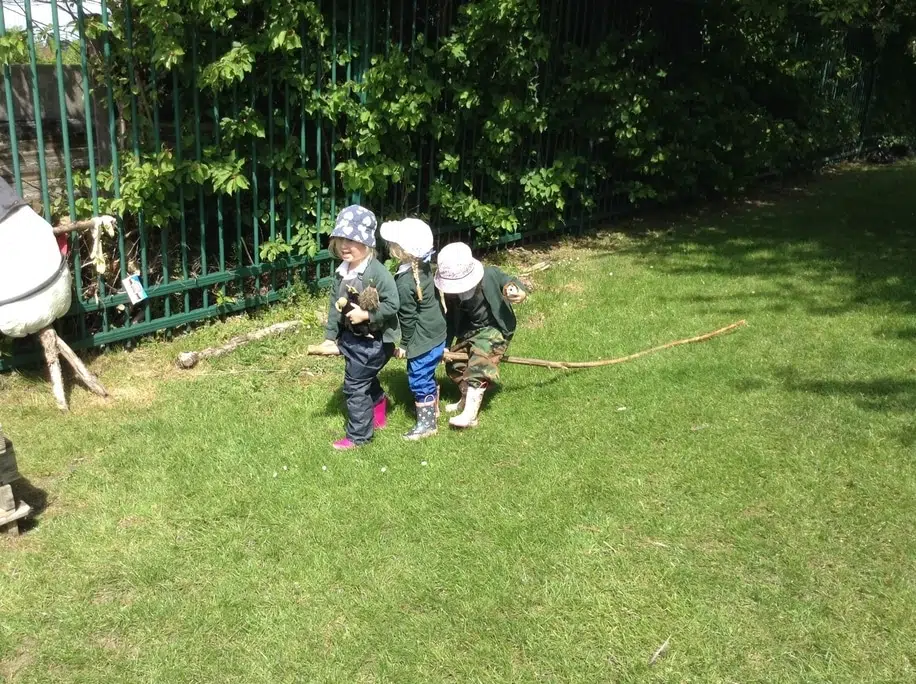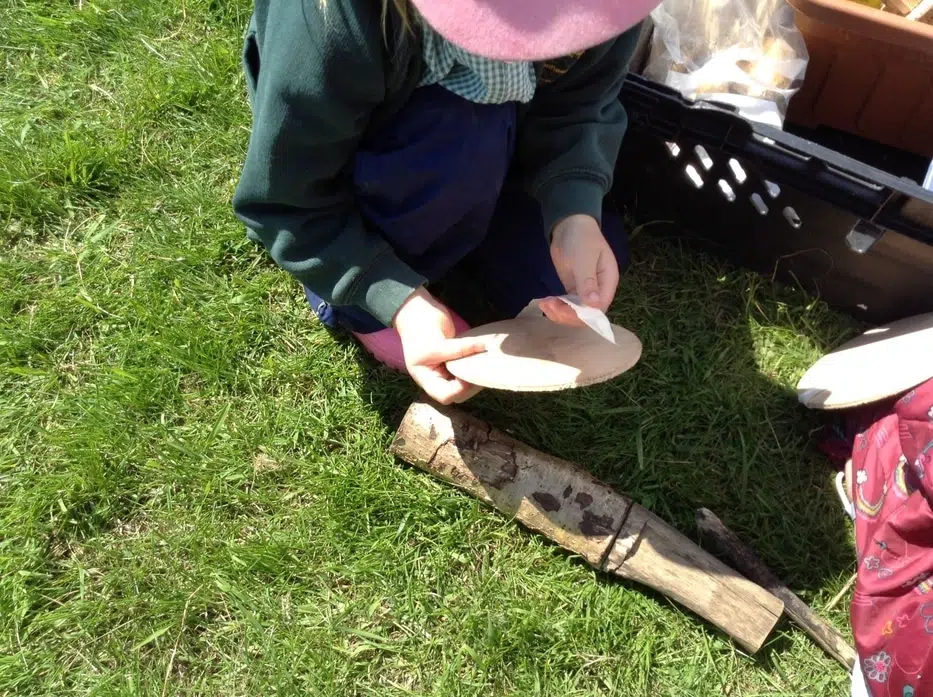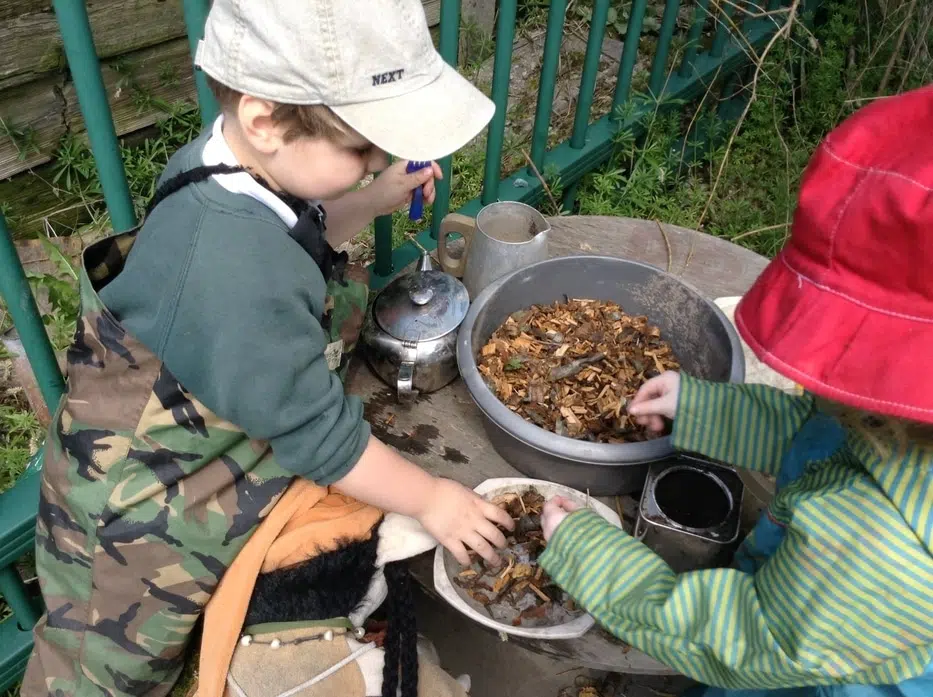There are so many children these days that are obsessed with superheroes. Superhero play infiltrates everything: games involving the Three Little Pigs are suddenly invaded by the Hulk and Spider Man.
Many practitioners are learning that superhero play is probably something better to work with, rather than stamp out. If the children are so passionately interested in it, then it can definitely be a force for good.
This passion for superheroes can infiltrate into forest school sessions. Forest School works well with superheroes, as there is so much scope for missions, and danger.
Making superhero equipment such as shields or bows is a great way of utilising play with risky tools such as potato peelers or bow saws. Children can climb trees or logs on a ‘mission’ to save others. They can engage in risky play with a higher sense of purpose to their actions.
In this article I’m going to take a look at some practical superhero activities that you can promote in your forest school setting for these superhero addicts amidst your ranks. Some of these are more adult-led, but any will just happen naturally. They are all simple, good fun, and guaranteed to be enjoyed by all children.
If you want to know a bit more about what forest school is then check this out first.

1.Making Shields
Superhero play in its many guises is a fantastic way of stimulating creativity.
The ultimate force for good in any environment is a superhero shield!
There are so many ways of making them. I was so pleased to visit Bradley Green Primary School in Manchester recently, and in their forest school the children were creating superhero shields using pieces of round wood. They were sticking the shields onto their forearms using masking tape. This was generating all sorts of exciting vocabulary and imaginative play.
You could also get the children to find pieces of wood, or sections of bark and tape them on.
So simple, and so fun.

2. Making Bows And Arrows
I also saw this at Bradley Green Primary. This was a really imaginative idea. It is a great way of utilising potato peelers for whittling sticks.
They got the children to find bendy sticks and whittled these down a bit by taking the bark off. Then they used wool to create a simple bow that actually could fire a small stick arrow a few yards. Using tools like this is a form of risky play that has many benefits for children. If you want to find out what they are then check this out.
3. Making Magic Wands
These are one of the ultimate outdoor activities.
These wands can be made out sticks found or brought in to the outside area. There are different things you can do to the wands, including:
- Wrap pieces of multicoloured wool or material around them. This is a brilliant fine motor activity and really gets the children focussed. These look really magical and engaging
- You can paint the sticks. It could be all one colour, or they could be patterned or covered in mysterious dots
- Tape things to them such as leaves
4. Superhero Hide And Seek
Children love hide and seek. It is an excellent way of exploring the danger of being away from others, or of being alone in the true sense.
A lot of children do not experience being alone very often in their lives.
There is also a thrill in being out of sight of others, and no one knowing where you are.
A superhero element can really add to this experience for some children. Taking on a character and then going into hiding in your superhero cave or similar deepens the experience, and brings the vital element of story into your actions.
5. Missions To Save Others
Children love to pretend that they are trapped, stuck, or kidnapped! They enjoy calling for help, and that feeling of vulnerability and need to be saved!
Enter the superheroes!
They must traverse the terrain, search high and low, and finally find the victims.
When found they can take them away to safety, often for the whole process to begin again.
6. Stick Play
In forest school settings children are encouraged to play with sticks. They use them in so many different ways! Sticks could be many things including:
- Wands
- Dogs
- Magic broomsticks
- Light sabres
- Horses
- Walking sticks
- And so many more…
Using stick like this is loose parts play in action. If you want to find out the many benefits of loose parts play then you can read this article.
7. Building Hideouts
Den building takes on many forms in forest school.
It can be an adult-led experience, with children helping to construct an A frame from logs and tying and binding them together.
Alternatively, it can be more child-led, with children placing tarpaulins or rugs over trees or bushes.
Either way, a superhero element can really bring it to life. It could be the superhero hideout. Or the safety zone away from the baddies.
A storytelling element really enhances this experience and gives it purpose and vitality.
8. Finding Hidden Objects Or Characters
This is a great way of introducing the children to an outdoor setting, and getting them to explore it for one of the first times.
Have some kind of toy or character that has suffered at the hands of a bad character. They are lost or trapped somewhere in the forest setting.
The superhero children are going to try to find them.
This encourages them to work together. It also
9. Pulling Others To Safety
Children will always find a range of obstacles when exploring forest school.
Some will always link a superhero connotation to these. For example, trying to cross the muddy puddle becomes a true superhero mission. What do they all need to all get across? This is just one example of many risky play activities that you can try.
You can model to children how to use objects to role-play these scenarios. For example, all riding a large stick like it is a horse. Or using a branch like a rope.
Children can use objects as representations of many other type of equipment.
Leaves could be a crown.
Grass a ring.
There are so many possibilities.
10. Team Missions Into The Unknown
The element of team-bonding is mixed up heavily in this. Superheroes invent all sorts of fantastical missions in the unknown.
They must go and rescue others.
They must go and find the evil baddie and defeat them.
One of the heroes has been kidknapped and they must go and find them.
Whatever the context, inventing stories and roles and brings this collaborative learning to life and gives it a greater enthusiasm.
11. Superhero Jumping
It is a great achievement to see children climbing up low items like logs or pallets and jumping off them for the first time.
There is that overcoming of danger, that sense of pride in coming through despite your personal fears.
Superhero role-play is often involved in these kind of scenarios. Superman has climbed to the top of the tower and must make a leap into the unknown.
Spiderman has weaved his way to the top of log using webs, and must now leap across the ravine.
Role-play and a sense of overcoming danger go hand in hand.
12. Making Magic!
Superhero powers and magic often go hand in hand.
Stones can be magical. They could be painted or drawn on. They could also be hidden in the ground.
A bowl can become a cauldron, filled with all sorts of magical leaves and blossoms.
Children love making potions! A few simple natural containers outside can be a fantastic starting point for creating simple potions with water, grass, daisies, leaves, and all sorts of other things. To find out the full guide to loose parts play outdoors then check this article out.
A pestle and mortar for mixing, some ladles and spoons, will create hours of fantastic learning and a deepening feeling of magic and the unknown.

Conclusion
There is of course more to life than just superheroes, and certainly it is always a good idea to introduce a range of characters and story-types to children. However, superhero play will always be a favourite of many, and you want to use it for your advantage.
If you’ve found this article useful, you will probably enjoy the following:
